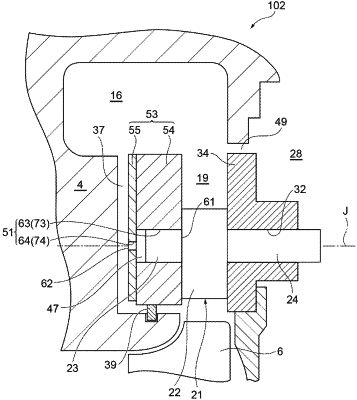| CPC F02B 37/24 (2013.01) [F01D 17/165 (2013.01); F05D 2220/40 (2013.01); F05D 2240/128 (2013.01)] | 20 Claims |

|
1. A variable capacity turbocharger comprising:
a housing;
a turbine impeller at least partially located in the housing;
a scroll flow path located in the housing and encircling the turbine impeller;
a first nozzle ring and a second nozzle ring facing each other in the housing;
a nozzle flow path located between the first nozzle ring and the second nozzle ring and fluidly coupling the scroll flow path to the turbine impeller;
a gap formed between the first nozzle ring and the housing, wherein the gap is located on an opposite side of the first nozzle ring to the nozzle flow path and is connected to the scroll flow path;
a nozzle vane located in the nozzle flow path and configured to adjust a flow rate of the nozzle flow path; and
a bearing hole located in the first nozzle ring and rotatably supporting a rotation shaft of the nozzle vane,
wherein the first nozzle ring comprises a ring main body part facing the nozzle flow path and a lid member joined to the ring main body part and facing the gap,
wherein the lid member includes an opening aligned along a rotation axis of the rotation shaft and located adjacent to the gap, and
wherein the opening penetrates the lid member to allow the gap and the bearing hole to communicate with each other.
|